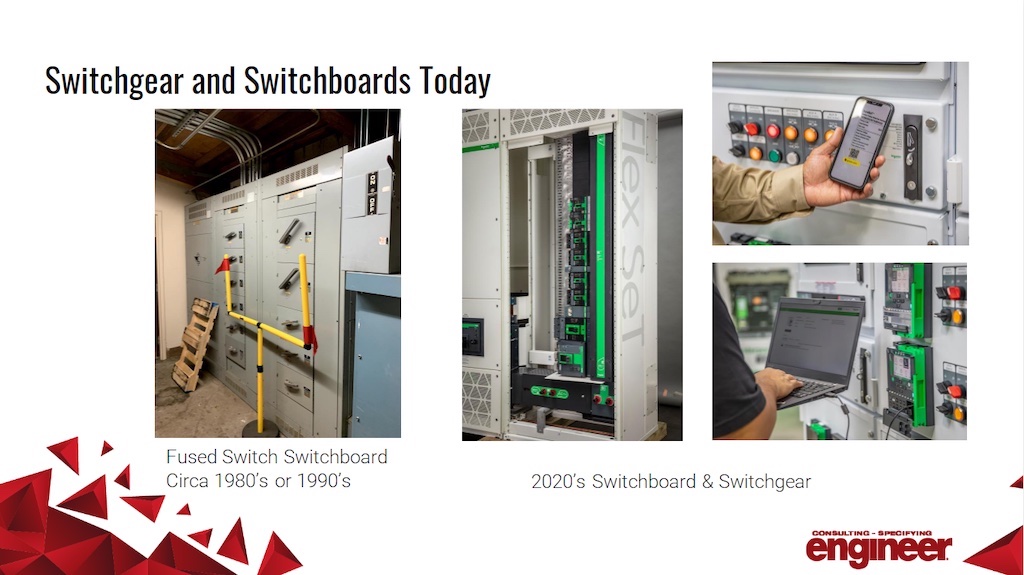Presenters Sean Hu and Andria Odrowski answer audience questions about switchgear and switchboards

Learning Objectives
- Understand major differences between switchgear and switchboards.
- Identify important codes and standards in electrical system design.
Switchgear and switchboard insights
- Arc flash safety in switchgear and switchboards is enhanced by the proper compartmentalization of overcurrent protection devices, bussing and cabling.
- Adequate space planning and right-sizing equipment are critical for the safe and sustainable operation of switchboards.
Both switchgear and switchboards are typical in electrical and distribution equipment but they have different use cases, costs and benefits. NFPA 70: National Electrical Code outlines a variety of components for electrical system design, including switchgear and switchboards.
In a June webcast, System Design Tips and Tricks for Switchgear and Switchboards,” expert presenters discussed switchgear and switchboards in more detail. Additional questions are answered here by Sean Hu and Andria Odrowski.
Do you see an increase in NEMA 3R outdoor versus NEMA 1 indoor applications?
Andria Odrowski: We haven’t really seen an increase from NEMA 3R to NEMA 1. It depends on your application and the location of the project. Medium voltage switchgear is more likely to be exterior. Also, it can be driven by the utility. Some utilities require exterior access to the service entrance switchboard or switchgear, driving more NEMA 3R.
What are some best practices to accommodate the electrical equipment on switchboards? Where can we standardize and be more sustainable?
Sean Hu: Adequate space planning to operate and maintain the equipment safely is important. There are standard components listed by UL, and the arrangement of these components may be unique to comply with the utility service provider’s requirements. In my opinion, sustainability will come from right-sizing the equipment and transformers. This will help meet the load and provide proper monitoring to study and understand load profiles so owners can evaluate the value of alternative and renewable power sources.

Can you explain the difference between fort-accessible and front-and-rear accessible switchgear design and application?
Sean Hu: The components in the switch gear need access for maintenance and cable routing. Front, rear or side access points will typically affect the application, as the geometry of the gear and sections may change based on where the access points are. Work with the vendor to determine the best application for the space you have available.
What are some arc flash considerations between switchboard and switchgear compartments?
Sean Hu: Consider the withstand ratings of the individual components and ensure they are adequate for the available fault current at that location in the system. Having compartments that separate over current protection devices, bussing and cabling can lead to increased safety.
How does employee safety factor into design?
Sean Hu: Safety is a top priority. Provide adequate space to operate and maintain the equipment safely. Ensure that withstand ratings are adequate for the available fault current. Having compartments that separate over current protection devices, bussing and cabling can increase safety for maintenance and operation staff.
Is fused switchboard available if a customer has a demand for it?
Andria Odrowski: The manufacturers we have checked with no longer have it as a standard product. This has also come up for distribution-type panelboards. In the past, we usually limited fused distribution to where it helped in selective coordination, but that is no longer a good option. The manufacturers are making their breakers smarter and testing more circuit breaker pairs to cover this need.
I just had an owner say they want fused switches in lieu of circuit breakers if the available fault current is above 35,000 ampere interrupting capacity (AIC). Are fused switches better than circuit breakers from that standpoint?
Andria Odrowski: Most switchboard manufacturers have standardized circuit breakers and eliminated fused switches as an option in their standard switchboard offerings. Because the manufacturers have put money into developing better breakers, circuit breakers are a good option. Up to 100,000 AIC is available from most manufacturers for most voltages and breaker sizes. Up to 200,000 AIC is also available for circuit breakers but may be more limited in voltages and frame sizes. If space is an issue, circuit breaker distribution usually has a smaller footprint than fusible devices.
What are some solutions for owners with inconsistent power, who are trying to understand why one leg is getting less power than the others in a three-phase system?
Sean Hu: This likely requires evaluation beyond switchgear and looking toward universal power supply or power conditioning to mitigate the issue. It may also be faulty equipment or the installation of existing electrical equipment.
What is the breakpoint for direct current (DC) and alternating current (AC) voltages?
Andria Odrowski: Per the NFPA 70: National Electrical Code (NEC), over 1000 volts alternating current is considered “high voltage.” The same code sections also apply to DC equipment over 1500 volts direct current.
Is there a rule of thumb to determine the physical size of switchboards?
Sean Hu: With experience specifying switchgear you will learn the standard chassis sizes from various manufacturers. In my experience, they often come in 24 inch, 36 inch and 42 inch wide compartments with depths from 48 inches, 60 inches and 72 inches. Choose the physical size to fit your space requirements and work with your manufacturer if you have custom requirements. Like a shoe, you can pick the model that fits best.
Do you find that manual interlocks (Kirk keys) are used more than electrically controlled interlocks?
Sean Hu: I see them both utilized. In facilities where continued operation is required, but an engineering team may not be on-sight 24/7, consider electrical controlled interlocks.
Is there a reliability difference (beyond the ability to work the equipment hot)?
Sean Hu: Both are reliable sources. Switchgear has options that can increase its resiliency beyond switchboards.



